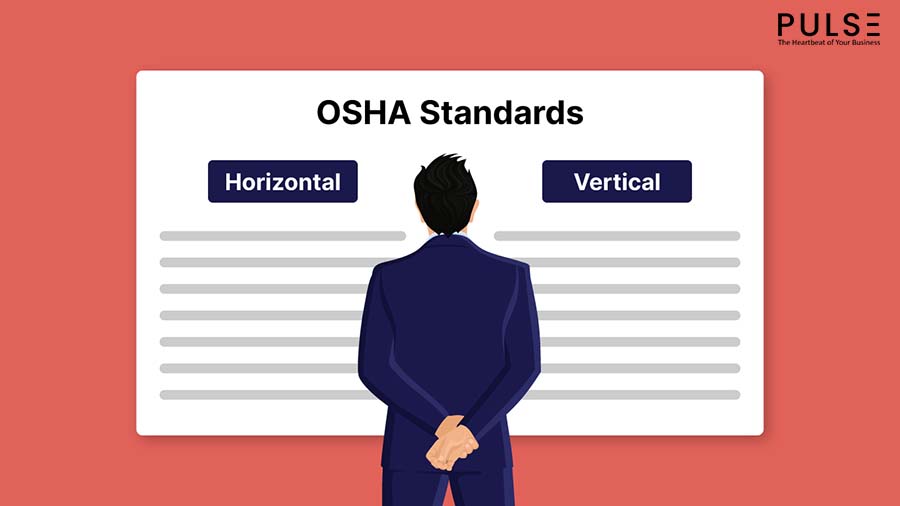Today, there are tens and thousands of different industries and businesses out there. Each workplace is different, and each of these different workplaces comprises different processes, materials, and types of workforce. As a result, every business has a set of specific risks, potential hazards, and innate issues associated with it.
Ergo, it is a real task for OSHA (The Occupational Safety and Health Administration) to set guidelines that cover all the occupational hazards across all the sectors! But one of the ways in which they have managed to do so is by categorizing and grouping the OSHA standards into ‘Horizontal’ and ‘Vertical’ standards.
In essence, the core mission of OSHA is “to ensure safe and healthful working conditions for workers by setting and enforcing standards and by providing training, outreach, education, and assistance.” OSHA is applicable to pretty much all private organizations and workplaces in the US, except for certain specific industries that fall under the exempted category or are covered by any other federal statute.
Once established to be falling under the ambit of OSHA, the businesses need to study and understand which OSHA standards are applicable to them before commencing operations if they wish to avoid OSHA penalties and audits. The first step of this process is to understand the categorization of the standards. So, let us understand the difference between ‘Horizontal’ and ‘Vertical’ OSHA standards.
OSHA Horizontal Standards
Also known at times as ‘OSHA General Standards’, these are the standards that are applicable to almost all the industries and businesses to whom OSHA is applicable. This is the compliance that every organization has to conform with, irrespective of the type of industry.
The OSHA horizontal standards have been established and put together after deliberations and consensus from representatives of different sectors. They mainly cover basic workplace hazards that may be present in any given organization; and, therefore, need to be covered for by the employer. Examples of OSHA horizontal standards are:
- First Aid
- Fire Protection
- PPE
- Hazard Communication
It is pertinent to note that most of OSHA’s standards are ‘general’ or ‘horizontal’ in nature.
OSHA Vertical Standards
OSHA Vertical Standards are the industry-specific guidelines that take into account the unique specificities of that particular sector and thereby try to cover all the associated workplace risks. Below are some of the sectors for which OSHA has defined standards explicitly:
- Construction Industry
- Maritime (Shipping) Industry
- Agriculture Industry
- Textile Industry
Each of these categories has certain specific risks and hazards linked with them, and hence has to adhere to tailor-made rules and regulations – the OSHA vertical standards.
For example, considering the nature of processes involved in the construction sector and the precariousness of the workplace locations, OSHA standards pertaining to scaffolding, power-operated tools, life-saving equipment, signs, barricades, etc., have been precisely drafted.
If we look at the Maritime industry, OSHA standards dealing with the availability of lifeboats, vessel radar and communication systems, access to confined cargo spaces, etc., are unique to this sector and are hence covered by the vertical standards.
Why is Knowing this Important?

Everyone is well aware of the consequences of non-compliance with OSHA standards. Not only is it an open invitation for OSHA Audits and Inspections, but hefty penalties, legal fees, worker compensation claims, and heavy insurance premiums are some of the ways in which the organization can lose financially. But, of course, the more critical aspect of non-compliance is that it risks the health and safety of the workers of the organization – and can even result in loss of life!
Therefore, businesses should make a thorough study of the different categories of OSHA standards; and the ones applicable – whether horizontal or vertical – should be diligently complied with. Sometimes, these two categories can be integrated to make the workplace even safer for workers. For example, for the hospitality or restaurant industry, horizontal standards for fire safety are applicable. However, they can make their OSHA compliance even more robust (and thereby their workplace safer) by complying with specific vertical standards relating to fire protection.
Get the Pulse of the Industry
Staying on top of all these standards and compliance is difficult, especially when operating the core business itself is no piece of cake. This is why we at Pulse would like to relieve you of this stress! With our intelligently designed checklists – customizable as per industry, powerful analytics, and insightful reports, we will ensure that your organization is always at the top of its game regarding compliance to OSHA standards – whether horizontal or vertical.
Not one’s asking you to take our word for it; we offer you a free demo so that you can see, firsthand, our contribution to your business and commitment towards compliance.
Sign up today to get instant access to our latest technology through a 30-day free trial!
